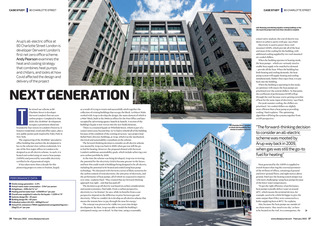




CASE STUDY | 80 CHARLOTTE STREET Arups all-electric office at 80 Charlotte Street London is developer Derwent Londons first net zero office scheme. Andy Pearson examines the heat and cooling strategy that combines heat pumps and chillers, and looks at how Covid affected the design and delivery of the project NEXT GENERATION T he mixed-use scheme at 80 Charlotte Street is developer Derwent Londons first net zero carbon project. Completed in May 2020, this 35,000m2 development occupies a prominent island site bounded by four streets in Londons Fitzrovia. It features residential, retail and office space, plus a new public pocket park inspired by Paley Park in New York. The engineering of the 30,000m2 speculative office building that anchors the development is key to the schemes low carbon credentials. It is one of the first major offices in London to be designed as an all-electric scheme. As such, it is heated and cooled using air source heat pumps (ASHPs) and powered by renewable electricity certified to be of guaranteed origin. It has taken more than a decade for this pioneering project to come to fruition, largely PERFORMANCE DATA Onsite energy generation 2.4% Annual mains water consumption 5.9m3 per person Airtightness 50Pa 3m3.h-1.m-2 Heating and hot water load 4.95kWh.m-2 per year Overall area-weighted U-value for the faade 1.32W.m-2.K-1 Systems design life 25 years Building design life 60 years Embodied carbon (A1-A5) 685kgCO2e.m-2 Annual CO2 emissions (TM54 regulated and unregulated figures) 25kgCO2.m-2 per year as a result of trying to retain and successfully stitch together the collection of existing buildings that occupy the block. Architect Make worked with Arup to develop the design, the main element of which is a 90m2 block, built in the 1960s as offices for the Post Office and later occupied by advertising agency Saatchi & Saatchi. A section of the buildings faade is now woven into the new-build elements. There is a retained faade on Whitfield Street, which is part of a conservation area; beyond that, weve had to rebuild all of the building because of the condition of the existing structure, says project lead Rahul Patel, director, buildings, at Arup, which was the mechanical, electrical and sustainability consultant on the scheme. The forward-thinking decision to consider an all-electric scheme was mooted by Arup way back in 2009, when gas was still the goto fuel for heating. However, the proposal chimed with Derwent Londons ambitious sustainability goals, which include achieving a net zero carbon portfolio by 2030. At the time the scheme was being developed, Arup was reviewing the potential for the electricity Grid to become greener in the future, and how this could result in buildings being designed to be all-electric, including the potential to be heated and cooled using heat pump technology. We discussed with Derwent a series of likely scenarios for the carbon content of Grid electricity, the unit price of electricity, and the performance of heat pumps, all of which we expected to improve over time, explains Patel. They trusted that our forward-thinking approach was right and that has paid off. The decision to go all electric was based on carbon considerations and sound economics, Patel adds. From a carbon perspective, electricity is a no-brainer, he says, while its benefits from a cost perspective depend on the difference in price between gas and electricity. What we couldnt do is develop an all-electric scheme that means the tenants have to pay through the nose for energy. The concept was proven to be viable two years into design development. By then, Arup was able to model the buildings anticipated energy use in detail. At that time, using a reasonably 36 February 2022 www.cibsejournal.com CIBSE Feb22 pp36-38, 40 80 Charlotte street.indd 36 28/01/2022 17:42